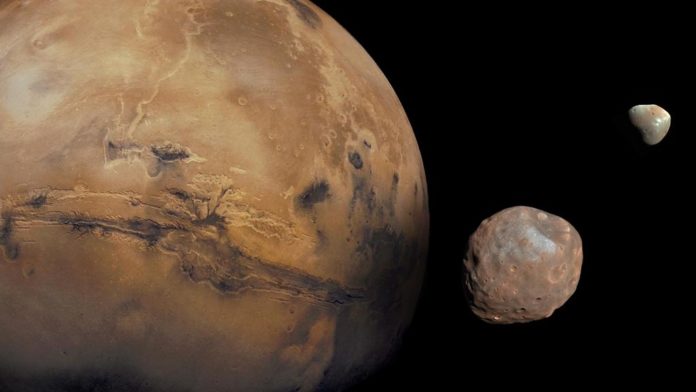The Martian moons Phobos and Deimos have similar shapes and colours to carbon-rich asteroids found in the asteroid belt. For many years, this is what planetary scientists believed they were: orphaned asteroids that had been caught by Mars’s gravitational pull.
Now, new research suggests that these moons were more likely to have formed in a cataclysmic impact many years ago, much like the Giant Impact Hypothesis explaining how our own Moon formed.
The paper, led by Timothy Glotch of Stony Brook University and co-authored by Chris Herd of the University of Alberta, was published in the Journal of Geophysical Research: Planets.
While the dark surfaces of Phobos and Deimos may resemble asteroids, the circular shapes and low angles of their orbits don’t fit the capture hypothesis. Captured moons are often tilted relative to their host planets, and have highly elliptical orbits.
If Phobos and Deimos really are adopted asteroids, some mechanism would have had to cause their orbits to circularize and align with Mars over time. But whether or not such a drastic change in their orbits is possible has been the subject of debate in the planetary science community for decades.
Glotch, Herd, and colleagues tackled the problem from a new perspective. Rather than trying to fit the moons’ orbits into the capture hypothesis, they asked themselves if the moons really were as similar to asteroids as they might appear.
The team re-analyzed observations of Phobos collected by the Mars Global Surveyor more than 20 years ago, and compared them to the Tagish Lake meteorite: the remains of a carbon-rich asteroid found in northwestern British Columbia.
Although Phobos looked similar to the Tagish Lake meteorite in visible light, a comparison in mid-infrared light revealed that there was more to the story.
“We found, at these wavelength ranges, the Tagish lake meteorite doesn’t look anything like Phobos,” Glotch said in a press release.
The mid-infrared observations of Phobos more closely resembled ground-up basalt, or volcanic rock. Interestingly, this is exactly what the Martian crust is made up of.
This led the authors to suggest that instead of being captured asteroids, Phobos and Deimos may be remnants of a long-ago impact between Mars and another rocky object in the solar system.
“There’d be lots of debris that came off of that,” Herd told the Globe and Mail. “If that was the case, then … you’d probably end up producing a whole bunch of objects in orbit around Mars and Phobos and Deimos are the ones that are left.”
While these results don’t confirm how Phobos and Deimos formed, they do bring planetary scientists one step closer to understanding these mysterious Martian moons.
And luckily, it may not be long before the mystery is solved: Japan’s Mars Moons eXploration mission is set to bring a sample of Phobos back to Earth in 2029.










































